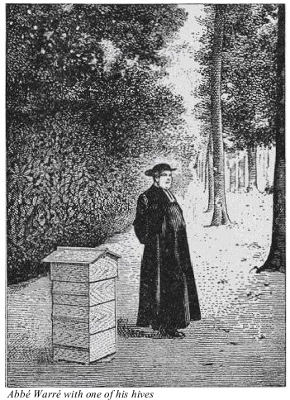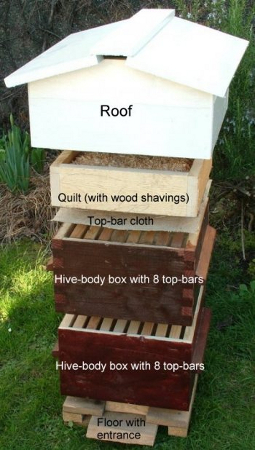
Warre vs. top bar hive
 Less well known than the top
bar hive is another alternative beekeeping box --- the Warre hive,
sometimes called a "vertical top bar hive." I have to admit that
I haven't read Abbe Warre's Beekeeping for All yet (although you can
download it for free by following the link.) The information
below is drawn from The
Barefoot Beekeeper,
and is clearly biased toward the author's method.
Less well known than the top
bar hive is another alternative beekeeping box --- the Warre hive,
sometimes called a "vertical top bar hive." I have to admit that
I haven't read Abbe Warre's Beekeeping for All yet (although you can
download it for free by following the link.) The information
below is drawn from The
Barefoot Beekeeper,
and is clearly biased toward the author's method.
Although Warre used
smaller boxes, his technique is very similar to the modified Langstroth
method I've used in the past (although less intrusive.) Warre
stacked small boxes (12 inches square and a bit over 8 inches deep)
just like in a Langstroth hive, with the major difference being that
his frames were merely top bars with wax strips. When the first
box was full of bees and honey, Warre slipped an empty box underneath
(similar to my swarm prevention in years past, but without the extra checkerboarding.)
 Where Warre's method differs
most from mine is that he didn't believe in delving into the hive at
intervals to page through the frames. In fact, he actually fixed
his frames in place with nails and didn't mess with the bees at
all. When they had moved down into the lower box, he would slip
another empty box underneath and then take away the top box, harvesting
all of the honey out of it at once.
Where Warre's method differs
most from mine is that he didn't believe in delving into the hive at
intervals to page through the frames. In fact, he actually fixed
his frames in place with nails and didn't mess with the bees at
all. When they had moved down into the lower box, he would slip
another empty box underneath and then take away the top box, harvesting
all of the honey out of it at once.
Warre's hive also
differs from Langstroth hives by containing a special, insulated
roof. Chandler argues that one of the problems with the
Langstroth hive is that the thin walls and roof cause condensation
within the hive in the winter, which makes the bees sick. Both
the Warre hive and the top bar hive deal with this problem by using
thicker wood and adding a sawdust layer to the inner lid.
PJ Chandler presented a
chart of pros and cons of the Warre hive versus his top bar hive, which you have to take with
a grain of salt since he clearly prefers the latter. Some
disadvantages he saw to the Warre method were:
- You have to store some boxes when not in use. The top bar hive is all one piece, so you block off empty areas but don't have to find space in the barn to store anything.
- More physical strength is
required for the Warre hive. Each time you add a new box
underneath, you have to hoist up the heavy box of bees and honey.
On the other hand, the
Warre hive did win in one respect:
- Very low maintence.
The top bar hive requires much more regular maintenance, with the
beekeeper often checking in and adding another frame twice a week
during heavy nectar flows. On the other hand, when you do work
with the Warre hive, you need to allot more time and physical strength
to the project.
I have to admit that I
think I'd drive myself nuts not being allowed to look into the hive
using Warre's method. On the other hand, there's always the
potential of creating viewing windows in the sides of the boxes, and if
the Warre method was better for the bees, I'd be tempted to try it.
Has anyone had
experience with Warre and/or top bar hives? Do you know of other
reasons to choose one over the other?
| This post is part of our The Barefoot Beekeeper lunchtime series.
Read all of the entries: |
Want more in-depth information? Browse through our books.
Or explore more posts by date or by subject.
About us: Anna Hess and Mark Hamilton spent over a decade living self-sufficiently in the mountains of Virginia before moving north to start over from scratch in the foothills of Ohio. They've experimented with permaculture, no-till gardening, trailersteading, home-based microbusinesses and much more, writing about their adventures in both blogs and books.
Want to be notified when new comments are posted on this page? Click on the RSS button after you add a comment to subscribe to the comment feed, or simply check the box beside "email replies to me" while writing your comment.

Anna,
I do not have any experience using the Warre hive.
I do agree with the insulation layer for the winter though. I use an all season inner cover (got mine from Honey Run Apiaries). This allows for two inches of rigid foam insulation.
With regards to condensation, I tip the hive forward with the goal that any drops will not land on the bees.
With regard to the honey harvesting in a Warre hive, I suppose you would be doing comb honey or crush and strain? Should work and would encourage clean wax because the bees would build it new every year.
I had read about people rigging up insulation under the cover for Langstroth hives, but had been unsure whether it would really help. Same to adding insulation to the walls. I'm still not entirely sure whether insulation vs. ventilation is the solution. (In chicken coops, the latter seems to be better for cutting down on winter damp.)
Crushing and straining does seem to be the method of choice for harvesting honey from both top bar and Warre hives.
Hi Anna - Are you familiar with Milkwood Permaculture? They're located down under, in Australia, and are a wonderful read for a cold winter day, especially since they're enjoying their summer right now. They started a Warre hive a while back, and have finally started peeking in - here's their latest entry: http://milkwood.net/2012/01/06/on-the-topography-of-honeycomb/
I hadn't heard of top bar hives before, so thanks for the explanation and comparison to the Warre method. Looking forward to reading more of your bee posts!
what kind of maintenance is done in the TBH that isn't done in the warre? im slightly new to beekeeping, don't have my own hive yet but am wondering which one to get the low maintenance of the warre sounds great, and the weight isn't a problem for me, but eventually my grandparents will probably be taking care of the hive if i decide to put one in this year, and less weight is just as important as low maintainence, though NOT more so so is there an article that deals with TBH maintainence on this blog or elsewhere that someone has a link to?
Devon --- I'm reading a book on Warre hives now, so I'll probably have a whole lunchtime series to share about them at some point. I think Warre hives are more like Langstroth hives --- more time all at once with lots of empty space in between. Top bar hives require a couple of minutes of maintenance as often as two or three times a week in the nectar flow. I suspect in the long run it all evens out to the same amount of time.
I'd recommend checking out The Barefoot Beekeeper for solid information on top bar hive maintenance. We haven't tried them yet, so can't give you real information yet.